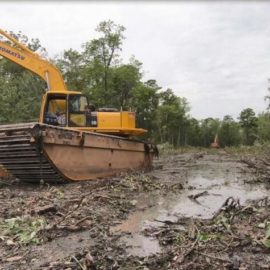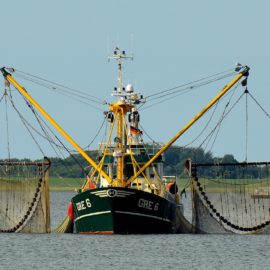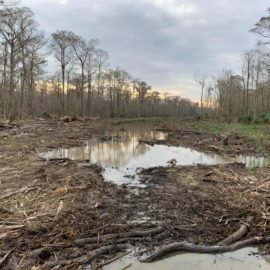
Old fashioned but it worked. Now pumps built to last 35 years go 5.
It was unsettling news for those who remember Hurricane Katrina: Pumps that form key parts of New Orleans’ new flood protection system have already corroded to varying degrees – and the damage could turn out to be more widespread when inspections are complete. The revelation made public last week has set off an effort to finish temporary repairs ahead of the June 1 start of hurricane season and an intensive look at what may have caused the problem. Whatever the ultimate cause, this much is clear: The pumps at the three main outfall canals meant to help keep the city dry during hurricanes were intended to last 35 years. Yet just five years after construction was complete, heavy corrosion has turned up in one of the 17 pumps and lesser damage in others.
nola.com
The Corps of Engineers say they will be fixed but there is sufficient overlap to keep us safe.
The Army Corps of Engineers, which oversaw construction, says it is committed to finishing temporary repairs before June 1 and has contingency plans in place if needed. As the situation stands now, the Corps insists there will be enough capacity in the system to deal with the effects of hurricanes. The state will not be on the hook for the cost of repairs or longer-term remedies, though it is unclear if the joint venture contracted to build the pump stations or the pump manufacturer will eventually be required to pay. It is also not the first time corrosion has caused issues with pumps on the same canals. Temporary pumps employed after Katrina and left in place past their intended lifespan – the result of delays in building the new stations – also corroded. Corps spokesman Ricky Boyett said the contract specifications for the new pumps spelled out a 35-year lifespan. “The fact of the matter is, they’re not doing what they’re supposed to be designed for,” he said. “And that’s a factor that we have to address, to basically provide the pump station that we said we’re going to.”

(Army Corps of Engineers)
What is the root cause of these pumps that are separate from the S&WB.
The pumps, separate from those operated by the Sewerage & Water Board, are part of an elaborate, $14.6 billion flood protection system put in place after the levee breaches that inundated the city during Katrina. They are located in three structures designed to both keep storm surge out of the canals and pump water from within them into Lake Pontchartrain during hurricanes. Their importance cannot be overstated. Floodwalls along two of the canals – London Avenue and 17th Street – failed in the 2005 storm, contributing immensely to the engineering failures that flooded 80% of New Orleans and killed hundreds. The third canal is Orleans Avenue. The structures at the end of each, built at a cost of $726 million, are known as permanent canal closures and pumps, or PCCPs. When hurricanes arrive, the canals are shut off to block storm surge from rushing into them and prevent breaches. But because water continues to build up inside the canals while the gates are shut, it must be pumped out into the lake to assure it doesn’t rise above 8 feet, the level the Corps has determined would threaten floodwalls. That’s where the pumps come into play.
The pumps were put to a design offer and many are involved.
The three stations were built under a design-build contract awarded to a joint venture that includes Kiewit Louisiana Co., whose parent headquarters is in Omaha, Nebraska; Traylor Bros. Inc., based in Evansville, Indiana; and the M.R. Pittman group, located in St. Rose. The pump manufacturer was Patterson Pump, based in Georgia. All are helping to figure out the cause of the corrosion. “As a design-build team, we are now working together with (the Corps), the pump manufacturer and outside experts to establish the root cause of what occurred, which has yet to be determined,” the joint venture said in a statement. There was a long gap between when it became apparent there was a problem to when it was diagnosed, which the Corps attributes to initial false leads and the complicated process of inspecting the pumps’ interior. In July 2021, the Southeast Louisiana Flood Protection Authority-East, which oversees the system on the east bank, was carrying out routine maintenance at the London Avenue Canal station and saw a pump overheating. It notified state authorities, who alerted the Corps, said authority regional director Kelli Chandler.
Deeper inspection came after some other failures.
Early theories included the possibility that the pump station building had sunk and the pump had fallen out of line, or that the temperature sensor may have been faulty – both of which turned out to be incorrect. After troubleshooting failed, it was determined in May 2022 that the pump needed a deeper inspection. The Corps “does not have the necessary in-house equipment and resources to dewater, inspect and repair the pump,” said Boyett, so it had to hire another company, Lakey Inc., to perform those tasks. The system had enough capacity for last year’s hurricane season, according to the Corps. When the bay holding the pump could be drained and the pump taken apart, corrosion was determined as the cause in February, which led to concerns that there was a systemic problem throughout all pumps, said Boyett. Inspections elsewhere have been underway, starting with the smaller pumps first at Orleans and 17th Street. Minor corrosion was found at two Orleans pumps, with one already cleaned up and the other being addressed. Work is also ongoing at the London Avenue pump that first came to authorities’ attention. “The Corps has assured us that they will do everything necessary to move water, whether it’s temporary pumps, whether it’s different alternative measures,” said Chandler. “They feel confident that they can move the water out of the canals if we have an event.”
There is another pump that can handle the load but if it goes down then thought is needed.
Boyett said enough capacity remains at London Avenue with one pump down, but a second pump down at that location would require the Corps to look at contingency plans. Ignacio Harrouch of the state Coastal Protection and Restoration Authority said “these types of systems are all affected by corrosion,” but added that the high-tech sensor and monitoring system in place helped prevent the situation from escalating. “Without these systems, we could have had a catastrophic failure to the pump,” he said. “As such, we have the opportunity to make the necessary repairs to the pumps to ensure that we meet the 35-year life.” Matt Miltenberger, a corrosion specialist with VCS Engineering Inc. of Tampa, Florida, said microbes in the lake’s brackish water could be to blame, possibly the result of sewage-contaminated runoff from New Orleans streets. The microbes can also be spurred on by nutrients from the Mississippi River. During repeat openings of the Bonnet Carre Spillway over the past 10 years, nutrient-rich river water often moved into the area of the pump stations.
The composition of the pumps might be a bad mix for the water.
Repair reports indicate that the temporary pumps that corroded after Katrina were built with carbon steel, which were subject to corrosion in the canals’ brackish water. The possibility was raised repeatedly during installation, first by longtime Corps critic and mechanical engineer Matt McBride, and by then-Corps engineer Maria Garzino. Garzino said the temporary pumps were “inadequately tested and vulnerable to failure” in whistleblower complaints filed with the Department of Defense’s Inspector General’s Office. The Government Accountability Office concluded that the Corps’ rush to get the pumps in place in advance of the 2006 hurricane season was a major culprit. “The pumping systems were installed prior to correcting these issues because the Corps believed it was better to have some pumping capacity along the drainage canals during the 2006 hurricane season rather than none, despite uncertainty over how much of the pumping system capacity would be available and for how long, if needed,” it said. As part of its more comprehensive review of the current situation, Corps experts will attempt to determine the cause of the corrosion and recommend ways the pumps can be modified or replaced to meet the 35-year requirement. That could include a review of the types of metal used in their construction.
I would look at the water first since two different pumps at different times have corroded.



